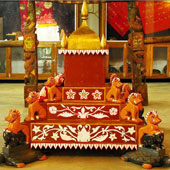The second most important feature of a Sattra is the Manikuta, which houses the valuable properties, attached east of the Namghar. It is referred to as the sanctum sanctorum in which the Guruasana (a wooden tetrahedral structure with four carved lions) is placed containing the main object of worship. It is pyramidal in shape with a square basement firmly standing on four pillars. There are seven steps in the Guruasana. In the basement of each pillar, there is an elephant on the tortoise. The seven lions on each elephant sum up twenty-eight representations of the seven heavens or Sapta Vaikuntha. According to the Holy Scriptures, it is believed there are seven heavens, seven earths, and seven hells, and each earth is carried on the back of a tortoise. The tortoise is represented as the earth's stand, and the elephant is represented as 'Paap' or evil deeds. The elephant, because of its heavy mass considered as one's evil deed, so in order to overcome, purify, and dominate the evil deeds. The lion motif is placed over it as a sign of strength and domination, i.e., good over evil.

• Lion, Elephant and Tortoise

The tortoise is represented as the earth's stand, and the elephant is described as 'paap' or evil deeds. The lion motif is placed over it as a sign of strength and domination, i.e., good over evil.
 A miniature model of the Guru Asana having three tiers instead of the original seven tiers. The peak of the asana holds the sacred book. The tiers are made out of wood while the lion, elephant, and tortoise figures are carved out from wood itself and later painted on with synthetic paints.
A miniature model of the Guru Asana having three tiers instead of the original seven tiers. The peak of the asana holds the sacred book. The tiers are made out of wood while the lion, elephant, and tortoise figures are carved out from wood itself and later painted on with synthetic paints. Patterns are mostly floral and are symmetrical in nature.
Patterns are mostly floral and are symmetrical in nature.
The tortoise is represented as the earth's stand, and the elephant is described as 'Paap' or evil deeds. The lion motif is placed over it as a sign of strength and domination, i.e., good over evil.
 Seven Tier Guru Asana with a richly woven piece of textile draped over it called the Gohain Kapor. The tiers are made out of wood while the lion, elephant, and tortoise figures are carved out from wood and later painted on with synthetic paints.
Seven Tier Guru Asana with a richly woven piece of textile draped over it called the Gohain Kapor. The tiers are made out of wood while the lion, elephant, and tortoise figures are carved out from wood and later painted on with synthetic paints. The Gohain Kapor is a cotton/silk textile where the patterns are mostly floral and symmetrical in nature.
The Gohain Kapor is a cotton/silk textile where the patterns are mostly floral and symmetrical in nature.
• Lion, Elephant and Tortoise

The tortoise is represented as the earth's stand, and the elephant is described as 'Paap' or evil deeds. The lion motif is placed over it as a sign of strength and domination, i.e., good over evil.
 Seven Tier Guru Asana with a richly woven piece of textile draped over it called the Gohain Kapor. The tiers are made out of wood while the lion, elephant, and tortoise figures are carved out from wood and later painted on with synthetic paints.
Seven Tier Guru Asana with a richly woven piece of textile draped over it called the Gohain Kapor. The tiers are made out of wood while the lion, elephant, and tortoise figures are carved out from wood and later painted on with synthetic paints. The Gohain Kapor is a cotton/silk textile where the patterns are mostly floral and symmetrical in nature.
The Gohain Kapor is a cotton/silk textile where the patterns are mostly floral and symmetrical in nature.
• Xorai, Saki and Dhuna Dani

This particular Xorai motif has a Bhagwat Geeta placed on it. The xorai is used as an offering tray for food and other items placed in front of the altar for blessing by the Lord. It is also accompanied by a saki (lamp) and a dhunadani, which is a vessel to burn resin during prayer.
 Seven Tier Guru Asana with a richly woven piece of textile draped over it called the Gohain Kapor. The use of typography in the fabric can be seen with the help of the Assamese script. The tiers are made out of wood while the lion, elephant and tortoise figures are carved out from wood itself and later painted on with synthetic paints.
Seven Tier Guru Asana with a richly woven piece of textile draped over it called the Gohain Kapor. The use of typography in the fabric can be seen with the help of the Assamese script. The tiers are made out of wood while the lion, elephant and tortoise figures are carved out from wood itself and later painted on with synthetic paints. The Gohain Kapor is a cotton/silk textile where the patterns are mostly floral and symmetrical.
The Gohain Kapor is a cotton/silk textile where the patterns are mostly floral and symmetrical.

